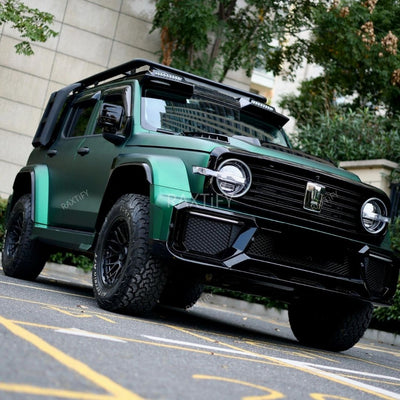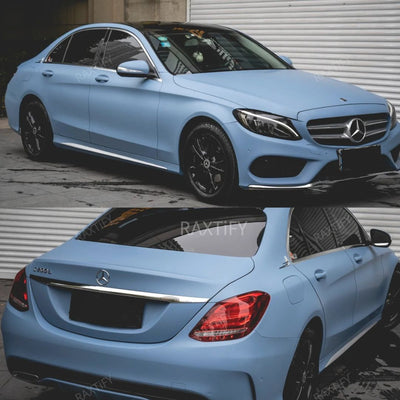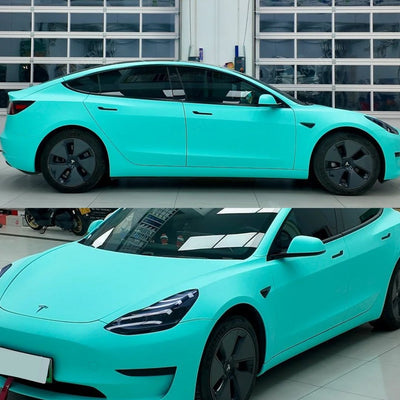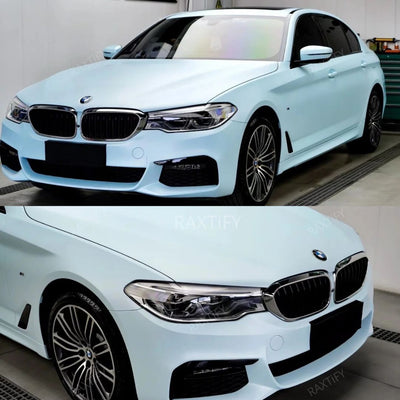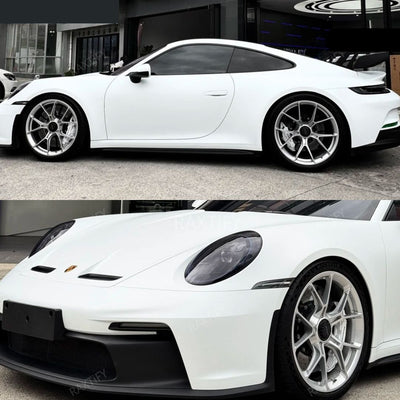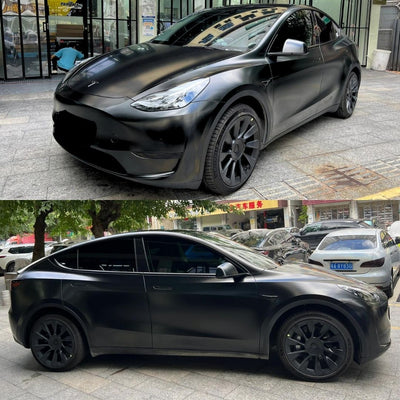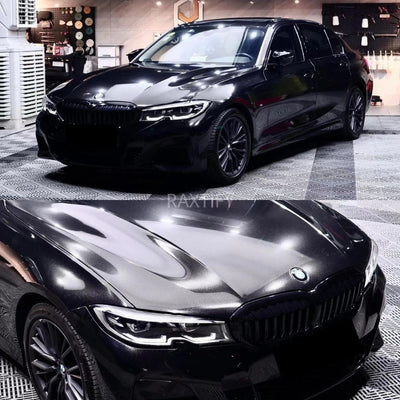
Considering that more than half of all cars come in monochromatic shades, your desire for a fresh appearance, a different color or finish, or something more artistic is entirely understandable. While a custom paint job was the traditional solution for years, the vehicle customization landscape underwent a revolution in the mid-1990s with the advent of vehicle vinyl wraps.
WHAT IS VINYL CAR WRAP?
While vinyl has been utilized since the 1950s for custom lettering, logos, and decals, the concept of fully wrapping a car in vinyl gained traction in 1993. This seemingly ordinary yet groundbreaking idea emerged when Germany mandated taxis to be colored beige, with no specific requirement for paint. Enter Kay Premium Marking Films, which rescued the day by introducing beige vinyl, enabling quick compliance with vehicle regulations for virtually any car within a few hours.
Vinyl car wrap is a composite of polyvinyl chloride (PVC) polymer, the origin of the term "vinyl," combined with various additives to ensure flexibility, resistance to ultraviolet light, and the addition of color. These components are blended, cast onto moving sheets, and subsequently baked and cured.
VINYL TRANSFORMATIONS
The resulting vinyl wraps can achieve an impressive thinness of just 2 mil, equivalent to two thousandths of an inch. Following the application of adhesive, these vinyl car wraps can be conveniently segmented into smaller rolls, catering to individual consumers, or dispatched to printers for the creation of custom graphics—ranging from the elegantly simple to the intricately complex.
In essence, a vinyl car wrap constitutes adhesive-backed plastic sheeting. However, the possibilities with a roll of plastic have evolved significantly in recent years. We have transcended beyond basic solid colors, witnessing a remarkable transformation in the car wrap industry. Innovators have introduced metallic, reflective, matte, gloss, pearlescent, and color-changing options. The spectrum extends further to include factory-matching hues and Pantone colors, not to mention the availability of beautiful, stunning, and intricate patterns and combinations.

GUIDE TO VINYL WRAPPING: ADVANTAGES AND DISADVANTAGES
If you're contemplating a transformation for your vehicle, whether through a paint job or vinyl wrap, each option comes with its own set of merits. Traditionally, a paint job has been the go-to choice, having stood the test of time for over a century. Achieving a flawless finish with paint necessitates the expertise of a professional and specialized equipment, elevating both the cost and time involved. Introducing multiple or unique colors, like pearlescent or metallic finishes, further extends the timeline and expenses. Graphics or personalized designs often require the meticulous touch of a specialist, typically done by hand.
Basic or customized paint jobs can endure for the entirety of a vehicle's life, potentially spanning decades. While permanence might be appealing, bold color combinations can be divisive. For a show car boasting a rich history, a custom paint job can significantly enhance its overall value. However, it also runs the risk of diminishing desirability—after all, not everyone desires a daily driver adorned with pink skulls.
VINYL CAR WRAP TECHNOLOGY ADVANCEMENTS
With the continuous evolution of vinyl car wrap technology, transforming the appearance of your vehicle is now more affordable than ever, especially if you prefer a DIY approach. While opting for professional vinyl car wrapping can be as costly as a traditional paint job, undertaking the project yourself can be surprisingly budget-friendly with a bit of patience and precision. The necessary tools are readily available and require no specialized licenses, training, or prior experience. Basic color changes, including multiple hues, typically don't significantly impact the overall project cost. However, incorporating custom graphics, prints, or unique finishes may elevate material expenses. Nevertheless, the final result can be truly remarkable.
Vinyl car wrap, by its very nature, lends itself well to temporary applications. With proper maintenance, a high-quality car wrap can endure for five to seven years, or even up to ten years. While this may not be ideal for those seeking permanence, it's perfect for drivers who desire flexibility. Whether you plan to alter the vehicle's look in a couple of years or prepare to sell it, removing a vinyl car wrap is a straightforward process requiring only a few basic tools and supplies. Importantly, it leaves the original finish unaffected. In fact, the original paint job may outshine one of a similar age, as vinyl car wrap acts as a barrier against UV light, preserving the resale value of your vehicle.

THE STEP BY STEP GUIDE ON HOW TO VINYL WRAP YOUR CAR
Embarking on the journey of vinyl wrapping your car can be intimidating, especially if past attempts with vinyl lettering or graphics left you frustrated. Despite meticulous surface preparation and personal readiness, issues like tears, bubbles, stretch marks, and wrinkles might have made a full vinyl car wrap seem like a task best left to the professionals. The landscape has evolved, thanks to advancements such as more durable vinyl, improved adhesives, and air-release technology. Now, achieving impressive results is within reach for even the most dedicated DIY enthusiasts. Ready to delve into the world of DIY car vinyl wrapping?
GETTING READY TO VINYL WRAP YOUR CAR
1. Assess your canvas, the surface you're wrapping. Ensure the body and paint job are smooth. While minor scratches aren't a major concern, chips, dents, gouges, and rust can pose issues with the vinyl wrap. If the wrap adheres to a defect, it increases visibility, and if it doesn't, it may bubble or tear, compromising the wrap job. Address these imperfections before proceeding with the car wrap.
2. Choose an appropriate location. While you don't need a sterile medical research cleanroom, a clean and controlled environment prevents dust from interfering with the wrap. Similar to paint and body defects, dust, debris, and bugs can impact the finish. Sweep, vacuum, and mop if necessary, and ensure doors are closed for an optimal vinyl wrap project.
3. Opt for a warm day. Both vinyl and vinyl adhesive are sensitive to temperature. The vehicle and wrap should be at a consistent temperature, ideally around 68 °F (20 °C). Colder temperatures can make the vinyl brittle and prone to tearing, while hotter temperatures may activate the adhesive too aggressively, making smooth installation challenging. Utilize a non-contact infrared thermometer to monitor the temperature. Consider planning the job for a specific time of day or allowing everything to acclimate for a few hours before starting.
4. Gather your tools, supplies, and materials. A standard car typically requires a 25-foot roll of 60-inch wide vinyl wrap. While narrower rolls are available, creating a seam can be tricky for a first-timer. Additionally, you'll need grease and wax remover, a general cleaner, 70- or 90-percent isopropyl alcohol, lint-free cloths or towels, a squeegee, utility knife, cutting tape, heat gun, infrared thermometer, and cotton wrap gloves. A clean worktable helps keep everything off the floor, reducing the risk of picking up dust. If possible, enlist a buddy for this project, as it aids in handling larger sections of vinyl wrap and provides moral support.













